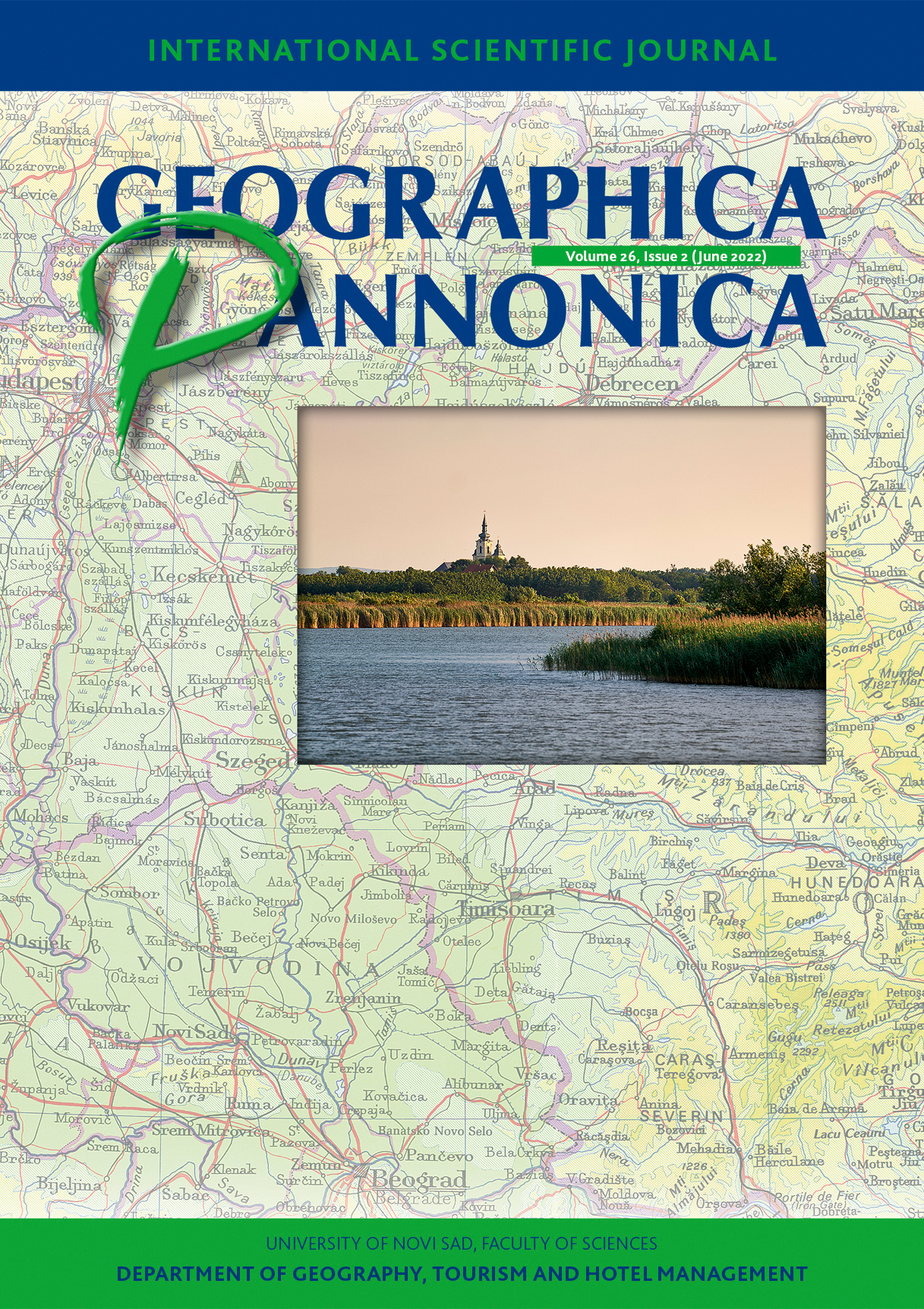GIS based methodology to analyse the public transport supply – Hungarian case studies
Abstract
The paper aims to introduce a new way of comparing the efficiency of public transport operations based on publicly available data. It draws on four main sources, the Hungarian Central Statistical Office, public transport provider data, GTFS and OSM map layers. Methodologically, it combines the use of the GTFS format and corresponding static timetable component files, Thiessen polygons and empirical selection of relative indicators. As places of research, three comparable Hungarian cities have been selected by their population size; Pécs, Szeged and Miskolc. The comparison consists of 8 quantitative indicators that cover six major geographical aspects of transport operation (accessibility in terms of proximity, capacity, connectivity, density, frequency and velocity of vehicles). The analysis does not consider the mode of public transport, thus opening up the possibility of an independent comparison of efficiency regardless of various infrastructure characteristics. The results show that Miskolc and Pécs achieved the best values in four indicators. On the contrary, the city of Szeged, despite its diverse structure of transport modes, does not have an advantage in any aspect. The relatively loosely anchored methodology leaves room for an extension to include economic, environmental, and other specific factors.
References
Bajčetić, S., Tica, S., Živanović, P., Milovanović, B., & Đorojević, A. (2018). Analysis of public transport users’ satisfaction using quality function deployment: Belgrade case study. Transport, 33(3), 609-618. https://doi.org/10.3846/transport.2018.1570
Bárta, M. (2020). Comparative analysis of the accessibility and connectivity of public transport in the city districts of Krakow. Transport Geography Papers of Polish Geographical Society, 23(3), 7-14. https://doi.org/10.4467/2543859XPKG.20.016.12784
Bárta, M., & Masopust, J., (2020). Multicriterial analysis of the accessibility of public transport stops in Cracow. Transport Geography Papers of Polish Geographical Society, 23(4), 32-41. https://doi.org/10.4467/2543859XPKG.20.025.13127
Biokom (2021). https://biokom.hu/ (30. 7. 2021)
Bok, J., & Kwon, Y. (2016). Comparable Measures of Accessibility to Public Transport Using the General Transit Feed Specification. Sustainability, 8(3), 224. https://doi.org/10.3390/su8030224
Birr, K., Jamroz, K., Kustra, W. (2014). Travel Time of Public Transport Vehicles Estimation. Transportation Research Procedia, 3, 359-365. https://doi.org/10.1016/j.trpro.2014.10.016
Bryniarska, Z., & Zakowska, L. (2017). Multi-criteria evaluation of public transport interchanges. Transportation Research Procedia, 24, 25-32. https://doi.org/10.1016/j.trpro.2017.05.063
Ceder, A., Le Net, Y., & Coriat, C. (2009). Measuring Public Transport Connectivity Performance Applied in Auckland, New Zealand. Transportation Research Record, 2111(1), 139-147. https://doi.org/10.3141/2111-16
Chowdhury, S., Ceder, A., & Velty, B. (2014). Measuring Public-Transport Network Connectivity Using Google Transit with Comparison across Cities. Journal of Public Transportation, 17(4), 76-92. https://doi.org/10.5038/2375-0901.17.4.5
DAKK (2021). https://www.dakk.hu/ (30. 7. 2021)
Gaal, G., Horváth, E., Torok, A., & Csete, M. (2015). Analysis of Public Transport Performance in Budapest, Hungary. Periodica Polytechnica Social and Management Sciences, 23(1), 68-72. https://doi.org/10.3311/PPso.7724
GTFS. (2021). General Transit Feed Specification. https://gtfs.org/ (30. 7. 2021)
Hadas, Y. (2013). Assessing public transport systems connectivity based on Google Transit data. Journal of Transport Geography, 33, 105-116. https://doi.org/10.1016/j.jtrangeo.2013.09.015
Hawas, Y. E., Hassan, M. N., & Abulibdeh, A. (2016). A multi-criteria approach of assessing public transport accessibility at a strategic level. Journal of Transport Geography, 57, 19-34. https://doi.org/10.1016/j.jtrangeo.2016.09.011
Háznagy, A., Fi, I., London, A., & Nemeth, T. (2015). Complex network analysis of public transportation networks: A comprehensive study, 2015 International Conference on Models and Technologies for Intelligent Transportation Systems (MT-ITS), (pp. 371-378). https://doi.org/10.1109/MTITS.2015.7223282
Išoraite, M. (2005). Analysis of transport performance indicators. Transport, 20(3), 111-116. : https://doi.org/10.1080/16484142.2005.9638006
KSH. (2021). Központi Statisztikai Hivatal. https://www.ksh.hu/apps/hntr.main?p_lang=HU (30. 7. 2021)
Kujala, R., Weckström, C., Darst, R. K., Mladenović, M. N., & Saramäki, J. (2018). A collection of public transport network data sets for 25 cities. Scientific Data, 5, 180089. https://doi.org/10.1038/sdata.2018.89
Luo, D., Cats, O., Lint, H. V., & Currie, G. (2019). Integrating network science and public transport accessibility analysis for comparative assessment. Journal of Transport Geography, 80, 102505. https://doi.org/10.1016/j.jtrangeo.2019.102505
Matulin, M., Mrvelj, Š., & Jelušić, N. (2011). Two-level Evaluation of Public Transport Performances. Promet - Traffic&Transportation, 23(5), 329-339. https://doi.org/10.7307/ptt.v23i5.151
Mavoa, S., Witten, K., McCreanor, T., & O’Sullivan, D. (2012). GIS based destination accessibility via public transit and walking in Auckland, New Zealand. Journal of Transport Geography, 20(1), 15–22. https://doi.org/10.1016/j.jtrangeo.2011.10.001
Medviď, P., Gogola, M., Kubaľák, S. (2020). Occupancy of Public Transport Vehicles in Slovakia. Transportation Research Procedia, 44, 153-159. https://doi.org/10.1016/j.trpro.2020.02.022
MVKZRT (2021). Miskolc Városi Közlekedési Zrt. https://www.mvkzrt.hu/ (30. 7. 2021)
OSM (2021). OpenStreetMap. https://www.openstreetmap.org/#map=7/46.012/20.632&layers=O (31. 8. 2021)
Prommaharaj, P., Phithakkitnukoon, S., Demissie, M. K., Kattan, L., & Ratti, C. (2020). Visualizing public transit system operation with GTFS data: A case study of Calgary, Canada. Heliyon, 6(4). https://doi.org/10.1016/j.heliyon.2020.e03729
SZKT (2021). Szegedi Közlekedési Társaság. https://szkt.hu/en/ (30. 7. 2021)
Transitfeeds (2021). Hungary. https://transitfeeds.com/l/61-hungary (30. 7. 2021)
Tüke Busz (2021). http://www.tukebusz.hu/ (30. 7. 2021)
Ušpalytė-Vitkūnienė, R., Šarkienė, E., & Žilionienė, D. (2020). Multi-criteria Analysis of Indicators of the Public Transport Infrastructure. Promet - Traffic&Transportation, 32(1), 119-126. https://doi.org/10.7307/ptt.v32i1.3175
Wang, S., Sun, L., & Rong, J. (2014). Transit Traffic Analysis Zone Delineating Method Based on Thiessen Polygon. Sustainability, 6(4), 1821-1832. https://doi.org/10.3390/su6041821
Wessel, N., Allen, J., & Farber, S. (2017). Constructing a routable retrospective transit timetable from a real-time vehicle location feed and GTFS. Journal of Transport Geography, 62, 92-97. https://doi.org/10.1016/j.jtrangeo.2017.04.012
Zhou, C., Zhang, D., & He, X. (2021). Transportation Accessibility Evaluation of Educational Institutions Conducting Field Environmental Education Activities in Ecological Protection Areas: A Case Study of Zhuhai City. Sustainability, 13(16), 9392. https://doi.org/10.3390/su13169392

